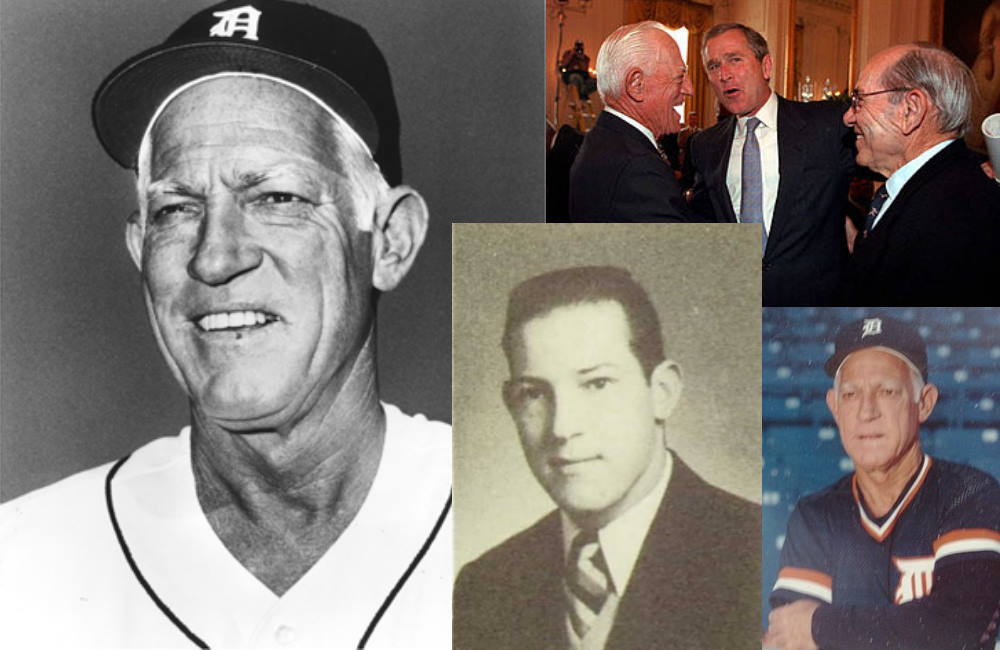Sparky Anderson’s career as a baseball player is unremarkable (just one year with the Philadelphia Phillies), but his career as a manager, on the other hand, is a completely different story. Although Anderson spent most of his career with the Detroit Tigers, he’s mostly remembered for his time as manager of the Cincinnati Reds, when the team earned the nickname the Big Red Machine.
Over the course of his career, he won five pennants and three World Series. The Baseball Hall of Fame inducted Anderson in 2000.
Early Life and Baseball Career
George Lee “Sparky” Anderson was born February 22, 1934, in Bridgewater, South Dakota. When he had reached the age of eight, his family moved to Los Angeles. After graduating high school, he began playing for the minors, starting with the Santa Barbara Dodgers.
He slowly worked his way up through the Dodgers system, and was given the nickname “Sparky” by a radio announcer while playing for the Fort Worth Cats. Before he could make his debut with the Dodgers, Anderson was traded to the Phillies. He would play in MLB for only one season in 1959, playing second base. He hit .218 and had just 34 RBI. After this less than spectacular showing, the Phillies sent Anderson back down to the minors. He later decided to call it quits as a baseball player.
Sparky Anderson’s Managerial Career
Anderson’s playing career may have been over, but in terms of his impact on baseball, this was only the beginning for him. His managerial career began in the minors. From 1964 to 1968, Anderson managed four different teams in the Reds and St, Louis Cardinals systems. In 1969, he coached for the San Diego Padres, and in 1970 he was set to manage the California Angels, but signed with the Cincinnati Reds instead.
At this point, Anderson remained relatively unknown, so his hiring surprised a lot of people. However, he quickly proved that he deserved the job. That season, the Reds won the National League pennant. Although they lost the World Series to the Baltimore Orioles, the fact that they made it there at all is impressive on its own.
Anderson would spend nine years managing the Reds, and how. The Reds won the pennant again in 1972 (although they lost to the Oakland Athletics), and they won two back-to-back World Series in 1975 and 1976 (against the Red Sox and New York Yankees, respectively).
During this impressive run, the Reds became known as the Big Red Machine due to their power and reliability. Anderson himself, meanwhile, was dubbed Captain Hook due to his ruthlessness when it came to switching out pitchers. Anderson even had a rule that pitchers were not allowed to speak to him when he came to the mound, in case they tried to change his thought processes.
Moving On To the Tigers
After the 1978 season, the Reds fired Anderson for refusing to change up his coaching staff. The Detroit Tigers then hired him as manager, a position he held for the next 17 years. Under Anderson’s leadership, the Tigers beat the Padres in the 1984 World Series, making him the first manager to have led a team from each league to the World Series.
However, Anderson’s time with the Tigers wasn’t all victories. In 1989 the Tigers lost a whopping 103 games, and the stress of losing hit Anderson so hard that he actually had to take a month-long break from the team. Anderson retired from managing after the 1995 season.
Over the course of his career, Anderson and his teams won seven division titles, five pennants, and three World Series. He was the first manager to win 800 games with two teams and the first to win the Manager of the Year award in both the National and American Leagues.
After Baseball
Following his retirement as a manager, Anderson spent a few years as a color commentator for the Angels. He also did work for the charity he’d founded, CATCH, which provides for sick children whose parents can’t afford healthcare. He passed away in 2010 at the age of 76.
Anderson was elected to the Hall of Fame in 2000. He had always put a lot of praise onto his players, and in his acceptance speech, he made sure to emphasize that it was his players who led the teams to victory. The Reds retired his jersey number, #10, in 2005, and the Tigers retired his #11 jersey in 2011.


Leave A Comment